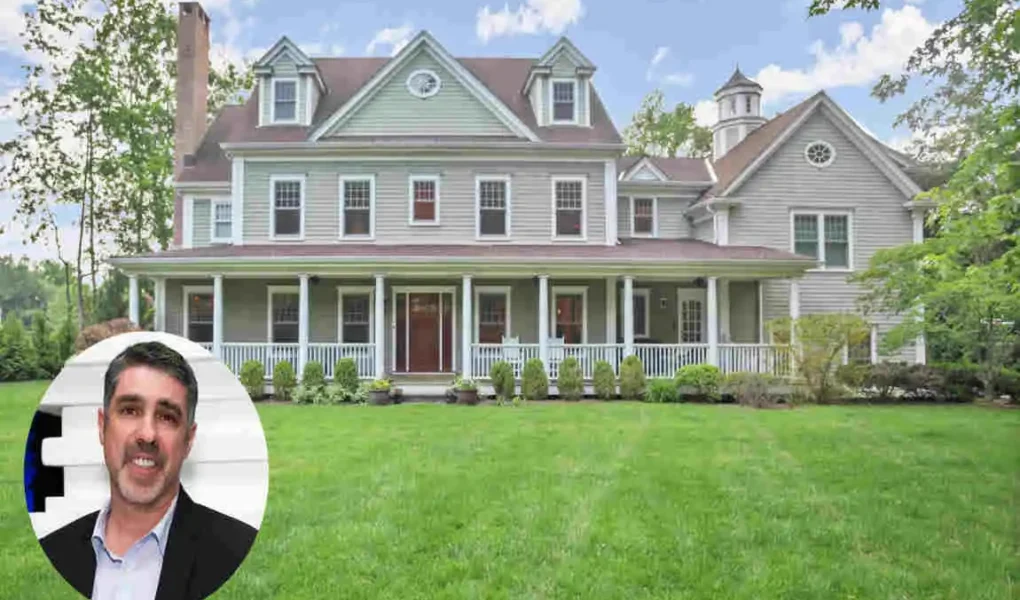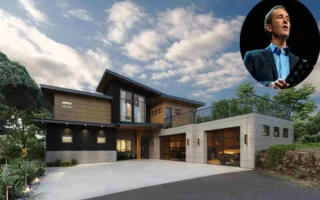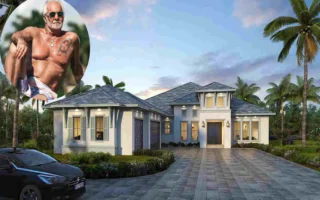Have you ever wondered what it’s like to step inside the Gary Delabate House? You’re about to embark on an exclusive visual journey through one of the most thoughtfully designed residences that perfectly balances modern luxury with everyday livability.
From the moment you approach the property, you’ll discover how every design choice reflects a deliberate vision. We’ll explore the stunning exterior architecture, walk through beautifully crafted living spaces, peek into private quarters, and experience outdoor areas that blur the lines between indoor and outdoor living. Whether you’re seeking inspiration for your own home or appreciate exceptional design, this detailed exploration offers valuable insights into creating spaces that are both beautiful and functional.
Exterior Architecture Tour
Façade Materials and Color Palette
The Gary Delabate House exterior design showcases a masterful combination of materials that create depth and visual interest. Natural stone cladding anchors the base of the home, providing a sense of permanence and connection to the earth. Above, smooth stucco surfaces painted in warm gray tones offer a contemporary contrast while maintaining cohesion with the stone below.
Wood accents appear strategically throughout the exterior. Cedar siding adds warmth to key architectural features, particularly around entryways and covered outdoor spaces. These wood elements have been treated to maintain their rich color while resisting weather damage. Metal details in a brushed bronze finish tie everything together, appearing in window frames, railings, and decorative elements.
The color palette draws from nature’s own spectrum. Soft grays dominate, punctuated by the warm browns of natural wood and the subtle variations in the stone. This restrained approach allows the landscape to provide seasonal color changes, ensuring the home looks stunning year-round without competing with its natural surroundings.
Landscape and Outdoor Living
Approaching the home, you’re guided by a thoughtfully designed entry sequence. The driveway curves gently, gradually revealing the house as mature trees frame the view. Landscape lighting illuminates the path at night, creating a welcoming atmosphere while highlighting architectural features.
The front yard balances manicured areas with naturalistic plantings. Native species dominate, chosen for their low water requirements and seasonal interest. Ornamental grasses sway in the breeze, while flowering shrubs provide bursts of color throughout the growing season. The hardscape features decomposed granite pathways bordered by steel edging, creating clean lines that complement the home’s modern aesthetic.
Side yards serve functional purposes without sacrificing beauty. One side accommodates utility access discreetly screened by attractive fencing and climbing vines. The other creates a private garden retreat, perfect for morning coffee or quiet reflection. These transitional spaces demonstrate how every square foot of the property has been thoughtfully considered.
Sustainable and Smart Outdoor Features
Environmental consciousness shapes many exterior design decisions. Solar panels integrate seamlessly into the roof design, nearly invisible from street level. The irrigation system uses smart controllers that adjust watering schedules based on weather forecasts and soil moisture levels, significantly reducing water waste.
LED lighting throughout the exterior provides energy-efficient illumination. Motion sensors activate pathway lights for safety and convenience while preserving dark skies when not needed. The outdoor lighting system connects to the home’s smart hub, allowing remote control and scheduling through smartphone apps.
Permeable paving in certain areas allows rainwater to recharge groundwater rather than contributing to runoff. Rain gardens at downspout locations filter stormwater naturally while adding attractive planted areas. These sustainable features prove that environmental responsibility and luxury design aren’t mutually exclusive.
Interior Overview
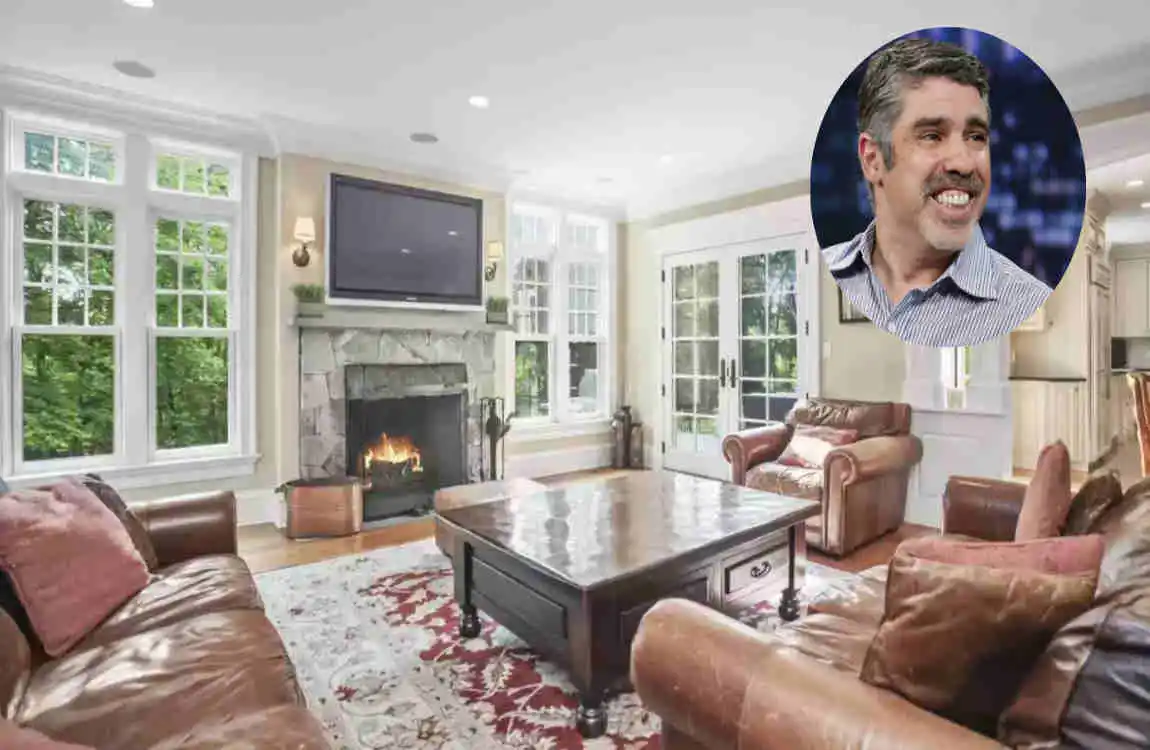
Ground-Floor Flow and Zoning
Step inside the Gary DeLabate house interior, and you immediately understand the thoughtful spatial planning. The foyer creates a gracious arrival experience without feeling overly formal. A double-height ceiling draws your eye upward while sight lines extend through to the living areas beyond, creating an immediate sense of openness and welcome.
The open-concept main level flows seamlessly between living, dining, and kitchen areas. Yet each zone maintains its distinct identity through subtle architectural cues. Changes in ceiling height, flooring materials, and lighting fixtures delineate spaces without walls. This approach maintains visual connection while allowing multiple activities to co-occur without interference.
Private areas remain discreetly separated from public spaces. A hallway leading to the home office and powder room branches off near the entry, allowing business meetings without disrupting the main living areas. The transition to the upper level, where bedrooms reside, feels intentional rather than abrupt, marked by a stunning staircase that serves as functional sculpture.
Palette, Materials, and Textures
The interior material palette echoes the exterior’s sophistication while adding layers of comfort. Wide-plank oak flooring runs throughout the main living areas, its natural grain providing warmth and continuity. Area rugs define conversation zones and add softness underfoot without covering the beautiful floors entirely.
Walls painted Benjamin Moore’s “Cloud White” create a neutral backdrop that subtly changes with shifting daylight. This choice makes spaces feel larger while allowing artwork and furnishings to take center stage. Accent walls in select locations feature grasscloth wallpaper or wood paneling, adding texture and visual interest without overwhelming.
Natural stone appears in key locations—the fireplace surround, kitchen backsplash, and bathroom surfaces. Each application showcases different finishes, from the soft, matte surface of honed marble to the reflective depth of polished granite. These varied textures create visual richness while maintaining color harmony throughout the home.
Natural Light and Views
Strategic window placement maximizes natural light while framing specific views. Floor-to-ceiling windows in the living room create an almost seamless connection to outdoor spaces. These aren’t just windows; they’re carefully composed frames for the landscape beyond. Automated blinds provide privacy and light control when needed without disrupting clean architectural lines.
Skylights punctuate key areas where wall windows wouldn’t work. Above the kitchen island, a linear skylight provides task lighting during day hours. The main bathroom features a skylight positioned perfectly above the soaking tub, allowing for stargazing during evening baths. These overhead light sources eliminate dark corners and reduce reliance on artificial lighting.
The home’s orientation ensures living spaces receive optimal light throughout the day. Morning sun fills the breakfast nook and kitchen, energizing the start of each day. Afternoon light warms the living room, while bedrooms face away from harsh western exposure. This thoughtful positioning enhances comfort while reducing heating and cooling energy costs.
Living Areas Spotlight
Living Room Centerpiece and Seating Arrangement
The living room serves as the heart of the Gary Delabate house, where design excellence meets everyday comfort. A striking linear fireplace stretches across one wall, its flames dancing behind glass, while the surround of book-matched marble creates a work of natural art. Above, a recessed niche displays rotating artwork, currently featuring an abstract piece that echoes the home’s color palette.
Seating arrangements accommodate both intimate conversations and larger gatherings. A sectional sofa in soft gray linen anchors the main seating area, paired with two swivel chairs upholstered in cognac leather. This combination provides ample seating while maintaining clear pathways through the space. A live-edge walnut coffee table serves as a functional centerpiece, its organic form contrasting beautifully with the room’s clean lines.
Layered lighting creates ambiance for any occasion. Recessed fixtures provide general illumination, while table lamps offer task lighting for reading. A stunning chandelier—custom-designed with hand-blown glass elements—serves as functional art. Innovative controls allow instant scene changes, from bright for daytime activities to dimmed for evening entertainment.
Kitchen and Dining Experience
The kitchen represents the pinnacle of the Gary Delabate kitchen design, where professional-grade appliances meet refined aesthetics. The massive island, topped with waterfall-edge quartzite, provides prep space for multiple cooks while doubling as a casual dining spot. Four upholstered stools tuck neatly beneath the overhang, their brass bases adding metallic warmth to the space.
Custom cabinetry in rift-sawn white oak provides abundant storage without overwhelming the space. Upper cabinets feature glass fronts displaying curated dishware, while lower cabinets hide everyday items behind solid doors. A walk-in pantry conceals small appliances and bulk storage, maintaining the kitchen’s streamlined appearance.
The dining area flows naturally from the kitchen, separated by a subtle change in ceiling treatment. A rectangular table in blackened steel and wood seats eight comfortably, with space to extend for larger gatherings. Above, a linear suspension light provides both task and ambient lighting. French doors open to the outdoor dining area, enabling seamless indoor-outdoor entertaining on pleasant days.
Media and Entertainment Hubs
Technology integration throughout living areas enhances entertainment without dominating design. The main living room features a 75-inch OLED television that disappears into a custom cabinet when not in use. Speakers built into the ceiling provide immersive sound without visible equipment. Everything is controlled through a single remote or smartphone app, simplifying the user experience.
A dedicated media room offers a more immersive experience. Theater seating for eight faces a 120-inch projection screen. Acoustic panels wrapped in designer fabric control sound while adding visual interest to walls. Automated blackout shades and dimmable sconces create the perfect viewing environment at the touch of a button.
The game room provides active entertainment options. A pool table in rich mahogany anchors the space, while a wet bar along one wall facilitates refreshment service. Built-in storage conceals board games and sporting equipment. This flexible space easily transforms for a variety of activities, from poker nights to children’s playdates.
Private Quarters and Personal Touches
Master Suite Design
The Gary Delabate House main suite exemplifies luxury through thoughtful design rather than excess. Positioned for privacy and views, the bedroom feels like a boutique hotel suite tailored for daily living. A tray ceiling adds architectural interest while concealing indirect lighting that washes walls in warm light. The sleeping area faces away from the morning sun, ensuring restful sleep.
The bed wall features upholstered panels extending from floor to ceiling, creating a cocoon-like feeling while improving acoustics. Nightstands in walnut with brass hardware provide surface space and drawer storage. Reading lights mounted on swing arms eliminate cord clutter while providing targeted illumination. A sitting area by the windows offers a quiet retreat for morning coffee or evening reading.
The ensuite bathroom rivals any spa in its amenities and design. Dual vanities in white oak with marble tops provide individual grooming spaces. A freestanding soaking tub beneath a skylight creates a focal point, while the walk-in shower features multiple showerheads and a built-in bench. Heated floors ensure comfort on cold mornings, controlled by programmable thermostats for energy efficiency.
Guest Rooms and Flexible Spaces
Guest accommodations balance comfort with flexibility. Two guest bedrooms on the upper level each feature an ensuite bathroom and a walk-in closet. Neutral color schemes allow guests to feel at home while maintaining design cohesion with the rest of the house. Quality mattresses and blackout curtains ensure restful sleep, while workspace areas accommodate extended stays.
A third bedroom currently serves as a home office but can easily be converted into a guest room when needed. Built-in Murphy bed hardware hides behind custom cabinetry, transforming the space in minutes. This dual-purpose approach maximizes square footage without compromising functionality. The adjacent bathroom features a shower rather than a tub, acknowledging the room’s primary use as a workspace.
The basement level includes a guest suite with a private entrance, perfect for extended family visits or potential rental income. This self-contained unit consists of a kitchenette, living area, bedroom, and a full bathroom. While connected to the main house, it maintains privacy for both hosts and guests. Soundproofing ensures activities in either space don’t disturb the other.
Bathrooms and Detail Moments
Throughout the home, bathrooms showcase attention to detail that elevates everyday routines. Each space features unique tile patterns that add personality while maintaining overall design harmony. The powder room makes a bold statement with geometric wallpaper and a floating vanity in blackened steel. A vessel sink in white marble provides sculptural interest.
Secondary bathrooms balance style with practicality. Porcelain tile that mimics natural stone provides durability and easy maintenance. Quartz countertops resist staining and scratching. Medicine cabinets recess into walls, maintaining clean lines while providing storage. Exhaust fans with humidity sensors automatically preserve air quality.
Hardware selections throughout demonstrate consistency in design vision. Matte-black bathroom fixtures complement the home’s modern aesthetic while resisting fingerprints and water spots. Matching towel bars, robe hooks, and toilet paper holders create visual continuity. Even outlet covers and switch plates receive consideration, specified in colors that blend with wall finishes.
Outdoor Living and Entertaining
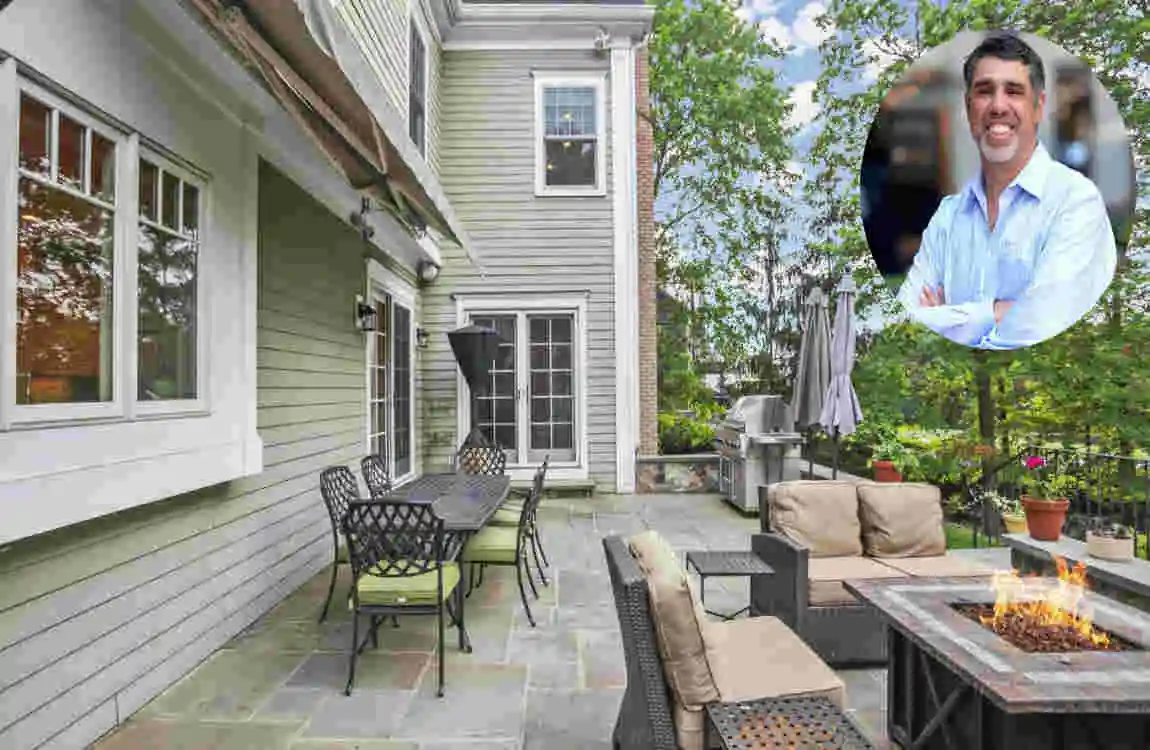
Patios, Decks, and Outdoor Rooms
The Gary Delabate House’s outdoor living spaces extend the home’s footprint significantly. The central patio, accessible from multiple indoor rooms, features large-format porcelain pavers that mimic natural limestone. This material choice provides durability and low maintenance while maintaining aesthetic appeal. The patio’s generous proportions accommodate multiple seating groups without feeling crowded.
A covered outdoor living room bridges indoor and outdoor experiences. Retractable screens provide insect protection while maintaining airflow. A stone fireplace anchors one end, creating ambiance and extending usability into cooler months. The ceiling features tongue-and-groove cedar planking with integrated speakers and fans. Comfortable seating upholstered in weather-resistant fabrics invites extended relaxation.
The outdoor kitchen rivals many indoor versions in its capabilities. A built-in gas grill with rotisserie, side burners, and warming drawer handles any cooking challenge. The refrigerator, ice maker, and sink eliminate trips inside during entertaining. A pizza oven adds versatility and becomes a gathering point during parties. Bar seating along the counter encourages conversation while the cook prepares meals.
Pool, Water Features, and Wellness Zones
The pool area serves as the backyard’s centerpiece, designed for both recreation and relaxation. The rectangular pool with a dark plaster finish creates a mirror-like surface, reflecting the sky and the landscape. An integrated spa spills into the main pool, providing soothing hydrotherapy. The pool’s innovative system maintains perfect chemistry while minimizing chemical use.
A separate wellness pavilion houses exercise equipment and a sauna. Floor-to-ceiling glass doors open completely, allowing workouts with fresh air and garden views. The infrared sauna provides health benefits and relaxation after exercise. An outdoor shower lets you cool off without going inside. This dedicated wellness zone acknowledges health as a design priority.
Water features throughout the landscape add movement and sound. A modern fountain near the entry creates a welcoming focal point. Along the pool’s edge, scuppers create gentle waterfalls that mask neighborhood noise. In the meditation garden, a small reflecting pool provides a contemplative element. These water elements work together to create a resort-like atmosphere.
Lighting, Security, and Smart Tech Outdoors
Landscape lighting transforms the property after dark. Path lights guide movement safely while uplighting highlights architectural features and specimen trees. Color-changing LED strips beneath outdoor kitchen counters and along pool edges add drama for entertaining. All lighting zones are controlled independently, allowing customized scenes for different occasions.
Security integrates discreetly throughout outdoor spaces. Cameras in architectural housings monitor property perimeters without appearing intrusive. Motion sensors trigger recording and alerts while ignoring small animals. Smart locks on gates allow remote access for service providers. The system interfaces with indoor controls, providing comprehensive property management from anywhere.
Outdoor technology enhances usability without compromising aesthetics. Weatherproof televisions in the covered living area and pool pavilion provide entertainment options. Outdoor speakers disguised as landscape rocks distribute music throughout the property. WiFi extenders ensure strong signals for working or streaming outdoors. Charging stations built into furniture keep devices powered during extended outdoor time.
Design Details Worth Noting
Art, Collectibles, and Focal Accents
The Gary Delabate House details reveal a carefully curated collection that adds personality without cluttering the spaces. Original artwork appears throughout, chosen for both aesthetic appeal and emotional connection. Large-scale pieces anchor major walls, while more minor works create intimate moments in hallways and powder rooms. The collection spans various media—paintings, sculptures, photography—unified by a consistent color palette.
Built-in display niches showcase collectibles and travel mementos. LED strip lighting within each niche highlights objects while eliminating shadows. Glass shelves maintain visual lightness. These architectural features transform personal items into design elements, integrating memories into the home’s fabric rather than simply placing them on surfaces.
Focal points in each room draw the eye and establish visual hierarchy. In the dining room, an oversized pendant light commands attention. The entry features a sculptural console table with an artistic mirror above. The main bedroom showcases a stunning headboard wall treatment. These statement pieces provide personality while maintaining the home’s sophisticated aesthetic.
Custom Built-ins and Storage Solutions
Storage solutions throughout demonstrate that organization enhances design. The mudroom features individual lockers for family members, each with hooks, shelves, and drawers sized for specific items. A bench with hidden storage provides seating for putting on shoes. The design acknowledges daily routines, making organization effortless rather than aspirational.
The library showcases floor-to-ceiling built-ins that accommodate books, media, and display items. Adjustable shelves adapt to changing needs. Lower cabinets conceal less attractive items. A rolling ladder provides access to upper shelves while adding vintage charm. The millwork’s quality rivals that of fine furniture, with details such as crown molding and fluted columns.
Closet systems throughout maximize storage capacity while maintaining accessibility. The pantry features pull-out drawers for easy access to items stored deep. Bedroom closets feature specialized storage for different types of clothing. Even the garage receives attention, with custom cabinets and wall systems organizing tools and sporting equipment. These solutions prove that beautiful design and practical storage aren’t mutually exclusive.
Sustainability and Efficiency Touches
Environmental consciousness influences decisions throughout the home. Insulation exceeds code requirements, reducing heating and cooling energy consumption. Triple-pane windows provide excellent thermal performance while reducing outside noise. The HVAC system features multiple zones, allowing different areas to maintain different temperatures based on use patterns.
Water conservation measures include low-flow fixtures that maintain performance while reducing consumption. The hot water recirculation system eliminates waiting for hot water, saving thousands of gallons annually. Drought-tolerant landscaping reduces irrigation needs. Rainwater harvesting provides supplemental irrigation during dry periods.
Material choices prioritize sustainability without sacrificing quality. Bamboo flooring, in particular, provides a rapidly renewable alternative to hardwood. Recycled content appears in insulation, countertops, and tile. Low-VOC paints and finishes maintain indoor air quality. Local sourcing for stone and wood reduced transportation emissions. These choices demonstrate environmental responsibility as a design principle.
Tech, Comfort, and Everyday Living
Smart Home Integration
The Gary Delabate House Smart Home System seamlessly blends technology into daily life. A centralized hub controls lighting, climate, Security, and entertainment throughout the property. Voice commands, wall panels, and smartphone apps offer multiple control options tailored to preferences and situations. The system learns patterns over time, automatically adjusting settings for optimal comfort and efficiency.
Lighting control goes beyond simple on/off switches. Preset scenes adjust multiple lights simultaneously for activities like dining, reading, or watching movies. Circadian rhythm lighting in bedrooms promotes better sleep by adjusting color temperature throughout the day. Vacation Mode randomly operates lights to simulate occupancy. Path lighting activates automatically for nighttime bathroom trips.
Climate control maintains perfect comfort while minimizing energy use. Smart thermostats learn schedules and preferences, adjusting temperatures before you realize you’re uncomfortable. Motorized shades respond to sun position and interior temperature, reducing solar heat gain. The system integrates with weather forecasts and pre-cools or heats based on expected conditions. Energy monitoring provides insights into consumption patterns and opportunities for savings.
Acoustic Considerations
Sound management throughout the home ensures peace and privacy. Insulation between floors and rooms reduces sound transmission. Solid-core doors with proper seals minimize noise transfer. The HVAC system uses sound-dampening materials and strategically routed ducts to operate quietly. These measures allow multiple activities to co-occur without disturbance.
The media room receives special acoustic treatment. Fabric-wrapped wall panels absorb reflections while maintaining an attractive appearance. The ceiling features acoustic tiles hidden above fabric. Bass traps in corners prevent low-frequency buildup. The result rivals commercial theaters in sound quality while maintaining residential warmth.
Even hard surfaces receive consideration for their acoustic impact. Area rugs in appropriate locations reduce echo in rooms with hard flooring. Upholstered furniture and window treatments provide sound absorption. Kitchen appliances chosen for quiet operation prevent interruptions to conversation. These details create a peaceful environment that enhances the quality of life.
Maintenance as Part of Design
Material and finish selections throughout prioritize long-term performance. Quartz countertops resist staining and scratching better than natural stone. Porcelain tile in high-traffic areas maintains its appearance despite heavy use. Exterior materials chosen for weather resistance reduce maintenance frequency. These practical choices ensure the home ages gracefully.
Accessibility for maintenance influenced design decisions. HVAC equipment locations allow easy filter changes and service access. Gutter systems include leaf guards and easy-clean features. Exterior light fixtures mount at reachable heights or include pulley systems for lowering. Windows tilt in for cleaning from the inside. These considerations reduce maintenance cost and hassle over the home’s lifetime.
The home includes a comprehensive maintenance manual documenting all systems, finishes, and recommended care procedures. Paint colors, material sources, and warranty information stay organized for future reference. Service contracts for major systems ensure professional maintenance occurs on schedule. This proactive approach protects the investment while maintaining the home’s pristine condition.
The Design Process and Collaborators
Who Designed and Built the Home
The Gary Delabate House Design Team brought together exceptional talent from various disciplines. The architectural firm, known for modern residential design, provided the overall vision and spatial planning. Their portfolio includes numerous award-winning homes that balance bold design with livability. The lead architect’s philosophy of “architecture as backdrop for life” perfectly aligned with the project goals.
Interior design came from a boutique firm specializing in high-end residential projects. Their approach emphasized creating sophisticated yet comfortable spaces that reflect the owner’s personality. The team’s expertise in material selection and furniture curation elevated every room beyond typical residential design. Their attention to detail ensured consistency throughout while allowing each space its own character.
The construction team’s reputation for quality craftsmanship and project management excellence made them the natural choice. Master artisans executed complex details with precision. The project manager maintained schedules and budgets while accommodating design refinements during construction. Subcontractors selected for specific expertise—from metalwork to smart home integration—contributed specialized skills that elevated the final result.
The Collaboration Workflow
The design process began with extensive programming sessions to understand lifestyle needs and aesthetic preferences. The team created detailed questionnaires to explore daily routines, entertainment preferences, and long-term goals. Site analysis examined solar orientation, views, and neighborhood context. This thorough preparation informed all subsequent decisions.
Design development proceeded through multiple iterations, each refining the concept. 3D modeling allowed virtual walk-throughs before construction began. Material sample boards ensured that all selections worked harmoniously together. The team encouraged owner input while providing professional guidance on technical and aesthetic considerations. This collaborative approach resulted in a home that genuinely reflects its owner’s vision.
Construction proceeded smoothly thanks to detailed documentation and regular communication. Weekly meetings kept all parties informed of progress and decisions. The team used project management software to track schedules, budgets, and communications. Quality control inspections at each phase ensured work met exacting standards. This organized approach minimized delays and cost overruns while maintaining design integrity.
Lessons for Readers
The project offers valuable insights for anyone planning a custom home. First, invest time in the planning phase. Thorough programming and design development cost far less than construction changes. Understanding how you really live, versus how you think you live, leads to better design decisions. Document everything—from inspiration images to must-have features—to communicate effectively with your team.
Budget realistically and include contingencies. High-quality materials and skilled labor cost more but provide better long-term value. Prioritize spending on elements you interact with daily—flooring, countertops, fixtures—over purely decorative items. Consider lifecycle costs, not just initial prices. Energy-efficient systems and durable materials save money over time.
Choose your team carefully and trust their expertise. Check references and visit completed projects. Ensure good chemistry—you’ll work closely with these people for months. Establish clear communication protocols and decision-making processes early. Remember that good design takes time; rushing compromises quality. The extra months spent in design can result in years of enhanced enjoyment.
Where Does Gary Delabate Currently Live?
Gary Dell’Abate’s most publicly reported residence in recent years is Old Greenwich, Connecticut.

